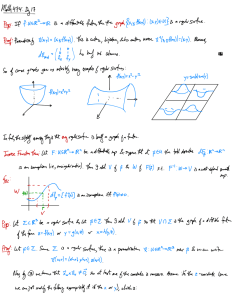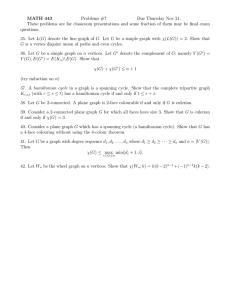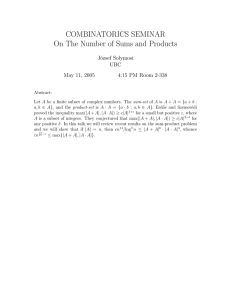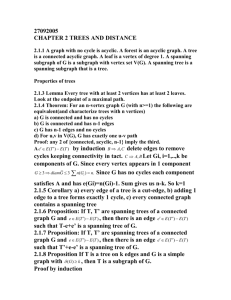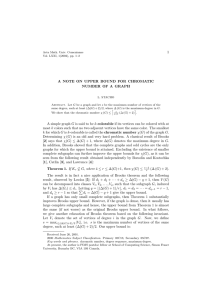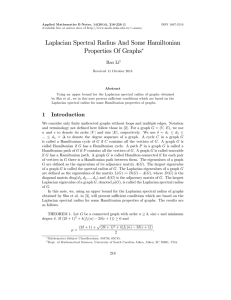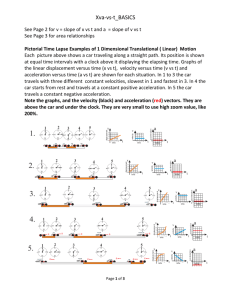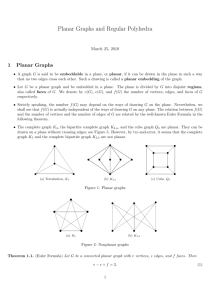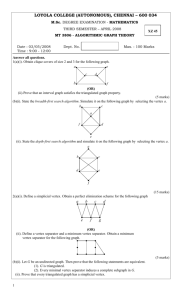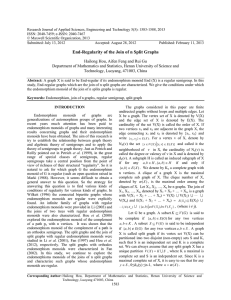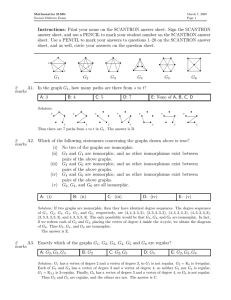On the Dependent Random Choice Technique Andrzej Dudek
advertisement
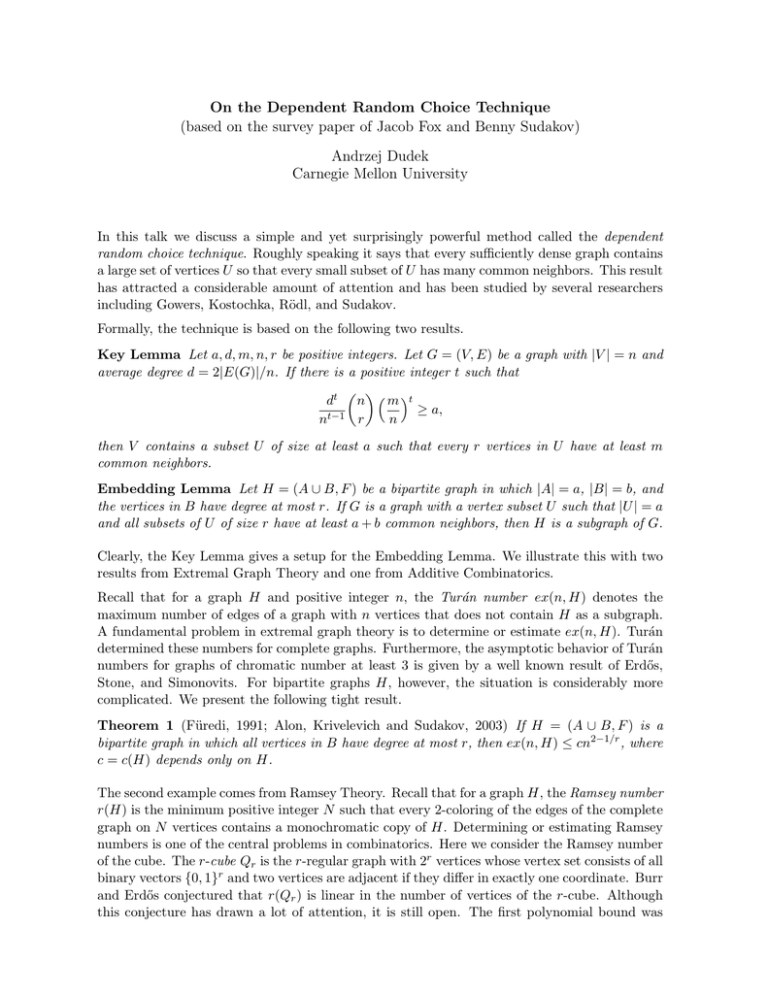
On the Dependent Random Choice Technique
(based on the survey paper of Jacob Fox and Benny Sudakov)
Andrzej Dudek
Carnegie Mellon University
In this talk we discuss a simple and yet surprisingly powerful method called the dependent
random choice technique. Roughly speaking it says that every sufficiently dense graph contains
a large set of vertices U so that every small subset of U has many common neighbors. This result
has attracted a considerable amount of attention and has been studied by several researchers
including Gowers, Kostochka, Rödl, and Sudakov.
Formally, the technique is based on the following two results.
Key Lemma Let a, d, m, n, r be positive integers. Let G = (V, E) be a graph with |V | = n and
average degree d = 2|E(G)|/n. If there is a positive integer t such that
dt n m t
≥ a,
nt−1 r
n
then V contains a subset U of size at least a such that every r vertices in U have at least m
common neighbors.
Embedding Lemma Let H = (A ∪ B, F ) be a bipartite graph in which |A| = a, |B| = b, and
the vertices in B have degree at most r. If G is a graph with a vertex subset U such that |U | = a
and all subsets of U of size r have at least a + b common neighbors, then H is a subgraph of G.
Clearly, the Key Lemma gives a setup for the Embedding Lemma. We illustrate this with two
results from Extremal Graph Theory and one from Additive Combinatorics.
Recall that for a graph H and positive integer n, the Turán number ex(n, H) denotes the
maximum number of edges of a graph with n vertices that does not contain H as a subgraph.
A fundamental problem in extremal graph theory is to determine or estimate ex(n, H). Turán
determined these numbers for complete graphs. Furthermore, the asymptotic behavior of Turán
numbers for graphs of chromatic number at least 3 is given by a well known result of Erdős,
Stone, and Simonovits. For bipartite graphs H, however, the situation is considerably more
complicated. We present the following tight result.
Theorem 1 (Füredi, 1991; Alon, Krivelevich and Sudakov, 2003) If H = (A ∪ B, F ) is a
bipartite graph in which all vertices in B have degree at most r, then ex(n, H) ≤ cn2−1/r , where
c = c(H) depends only on H.
The second example comes from Ramsey Theory. Recall that for a graph H, the Ramsey number
r(H) is the minimum positive integer N such that every 2-coloring of the edges of the complete
graph on N vertices contains a monochromatic copy of H. Determining or estimating Ramsey
numbers is one of the central problems in combinatorics. Here we consider the Ramsey number
of the cube. The r-cube Qr is the r-regular graph with 2r vertices whose vertex set consists of all
binary vectors {0, 1}r and two vertices are adjacent if they differ in exactly one coordinate. Burr
and Erdős conjectured that r(Qr ) is linear in the number of vertices of the r-cube. Although
this conjecture has drawn a lot of attention, it is still open. The first polynomial bound was
given by Shi. Here we show a very short proof of this result using the dependent random choice
technique.
Theorem 2 r(Qr ) ≤ |V (Qr )|3 .
In the remaining time of the talk we discuss the Balog-Szemerédi-Gowers theorem from Additive
Combinatorics. Let A and B be two sets of integers. Define the sumset A + B = {a + b : a ∈
A, b ∈ B}. For a bipartite graph G with parts A and B and edge set E, define the partial sumset
A +G B = {a + b : a ∈ A, b ∈ B, (a, b) ∈ E}. In many applications in Additive Combinatorics,
instead of knowing A + A one only has access to a dense subset of this sum. For example, can
we draw a useful conclusion from the fact that A +G A is small for some dense graph G? One
can show that in this case A + A can still be very large. Fortunately, we are still able to draw
a useful conclusion thanks to the following result.
Balog-Szemerédi-Gowers Theorem If A and B are two sets of size n, G has at least cn2
edges and |A +G B| ≤ Cn, then one can find A0 ⊆ A and B 0 ⊆ B with |A0 | ≥ c0 n, |B 0 | ≥ c0 n
and |A0 + B 0 | ≤ C 0 n, where c0 and C 0 depend on c and C only.
The original proof of Balog and Szemerédi used the Regularity Lemma and gave a tower-like
dependence between the parameters. Gowers’ approach gives a much better bound and it is
based on the following graph-theoretic lemma, which is also of independent interest.
Lemma Let G be a bipartite graph with parts A and B of size n and with cn2 edges. Then it
contains subsets A0 ⊆ A and B 0 ⊆ B of size at least cn/8, such that there are at least 2−12 c5 n2
paths of length three between every a ∈ A0 and b ∈ B 0 .
An essential ingredient in the proof of the above result is the following variant of the Key
Lemma.
Key Lemma (“linear” version) Let G be a bipartite graph with parts A and B and e(G) =
c|A||B| edges. Then for any 0 < ε < 1, there is a subset U ⊆ A such that |U | ≥ c|A|/2 and
at least a (1 − ε)-fraction of the ordered pairs of vertices in U have at least εc2 |B|/2 common
neighbors in B.
